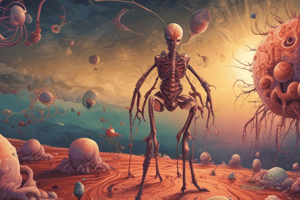Podcast
Questions and Answers
What is the most common site for skin snip technique collection?
What is the most common site for skin snip technique collection?
What is the purpose of staining biopsy tissue following the skin snip technique?
What is the purpose of staining biopsy tissue following the skin snip technique?
Which test involves administering DEC to produce an allergic reaction to confirm the presence of microfilariae?
Which test involves administering DEC to produce an allergic reaction to confirm the presence of microfilariae?
What percentage of microfilariae emergence can be seen within 30 minutes of skin incubation?
What percentage of microfilariae emergence can be seen within 30 minutes of skin incubation?
Signup and view all the answers
What reaction may a patient experience when taking the Mazzotti test?
What reaction may a patient experience when taking the Mazzotti test?
Signup and view all the answers
What is the primary region where Onchocerca cases are concentrated?
What is the primary region where Onchocerca cases are concentrated?
Signup and view all the answers
Which insect is responsible for transmitting Onchocerca larvae?
Which insect is responsible for transmitting Onchocerca larvae?
Signup and view all the answers
What is one of the early signs of Onchocerca infection?
What is one of the early signs of Onchocerca infection?
Signup and view all the answers
How long can adult Onchocerca live within nodules?
How long can adult Onchocerca live within nodules?
Signup and view all the answers
What characteristic distinguishes adult Onchocerca from other filarial worms?
What characteristic distinguishes adult Onchocerca from other filarial worms?
Signup and view all the answers
What symptom is associated with ocular onchocerciasis?
What symptom is associated with ocular onchocerciasis?
Signup and view all the answers
What kind of skin condition can Onchocerca infection cause, described often as a hanging groin?
What kind of skin condition can Onchocerca infection cause, described often as a hanging groin?
Signup and view all the answers
What method is used to diagnose Onchocerca infection?
What method is used to diagnose Onchocerca infection?
Signup and view all the answers
Study Notes
Onchocerca Volvulus
- Primarily affects Africa, with 96% of cases in the region.
- Common in Sudan (Abo-hamad, Nahr Atbara, and Nahr Eljour) regions, known as river blindness.
- Infective larvae (L3) transmitted via black flies (Simulium damnosum) found near fast running rivers.
- Adult worms encapsulated within subcutaneous tissue nodules.
Morphology
- Microfilariae are 300 µm long and 0.8 µm in diameter, lacking sheaths, with sharply pointed, curved tails and no nuclei at the tail end.
- The head end is slightly enlarged.
- Adult females are 45-50 cm long by 300 µm wide, and males are 20-40 mm long by 200 µm wide.
- They live in nodules for 8-10 years.
- Transverse striations, with annular and oblique thickenings on their cuticle aid in differentiation from other filarial worms.
Life Cycle
- Blackflies (Simulium) ingest microfilariae.
- Microfilariae mature into L3 larvae.
- Larvae penetrate blackfly midgut and migrate to thoracic muscles.
- Blackflies take blood meals and transmit the L3 larvae.
- Larvae migrate to subcutaneous tissues where they mature into adults.
- Adults produce microfilariae found in skin, lymphatics, occasionally in peripheral blood, urine, or sputum
Clinical Presentation
- Early sign is raised subcutaneous nodules (onchocercomas).
- Other inflammatory skin conditions include: papules, tissue-paper skin, hypo/hyperpigmentation (leopard skin, lizard skin, elephant skin), on limb hyperpigmentation (Swada or black skin disease (first reported in Yemen).
- Loss of elasticity in skin around the groin leading to a hanging groin.
- Ocular onchocerciasis: Microfilariae migrate to the eye, causing corneal and anterior chamber involvement, photophobia, lacrimation, and chronic conjunctivitis, eventually leading to blindness.
Diagnosis
- Skin snips: sterile needle to collect tissue sample of skin, which allows microfilaria emergence within 30 minutes.
- ELISA
- PCR
- Onchocerca skin test (detects IgG)
- Mazzotti test: 50 mg DEC orally. Severe itching within two hours due to allergic reaction to proteins released from microfilaria breakdown. Only use when necessary. Topically DEC (Nivea cream) patch test can be used.
Studying That Suits You
Use AI to generate personalized quizzes and flashcards to suit your learning preferences.
Related Documents
Description
This quiz explores the biology and life cycle of Onchocerca volvulus, the causative agent of river blindness predominantly found in Africa. Delve into its morphology, transmission via blackflies, and the unique characteristics of the microfilariae and adult worms. Test your knowledge and understanding of this important parasitic disease.



